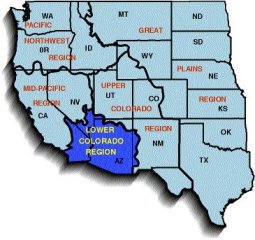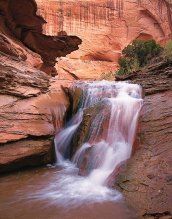Lower Colorado Region History
An Historic Overview
 The Lower Colorado Region is one of five administrative areas, established by geographical boundaries, that administer Bureau of Reclamation programs and projects in the 17 Western States. The LC Region was not formally established until 1943, even though Reclamation had started developing projects in Arizona, California and Nevada four decades earlier. The Region encompasses parts of five states that contribute water to or draw water from the Colorado River: southern California; southern Nevada; the southwest corner of Utah; most of Arizona; and part of west-central New Mexico.
The Lower Colorado Region is one of five administrative areas, established by geographical boundaries, that administer Bureau of Reclamation programs and projects in the 17 Western States. The LC Region was not formally established until 1943, even though Reclamation had started developing projects in Arizona, California and Nevada four decades earlier. The Region encompasses parts of five states that contribute water to or draw water from the Colorado River: southern California; southern Nevada; the southwest corner of Utah; most of Arizona; and part of west-central New Mexico.
Some of Reclamation's earliest and best-known projects - Theodore Roosevelt Dam, Hoover Dam, the All-American Canal, Parker Dam - are found in the LC Region, as are more recent projects such as the Central Arizona Project and the Robert B. Griffith Project (formerly the Southern Nevada Water Project). Many other lesser known but equally successful Reclamation projects can also be found in this Region. Large or not so large, these projects have all contributed significantly to the economic growth and development of Arizona, California and Nevada. And they will continue to be major contributors to the future development and quality of life in these states.
 Reclamation's program in the Lower Colorado Region was highly visible throughout most of the 1900s, as we built dams, power plants, canals, and transmission lines to help meet the Southwest's water and power needs. By the mid-1990s, our program focus had shifted more to the less-visible but equally important task of improving management of already-developed water resources. New and changing social needs and priorities were the driving force behind this change.
The demand for water in the Southwest is much greater today than it was when Reclamation began its work here in 1903. There is still a large agricultural water demand, of course. But there also is an increasing demand for water to meet the needs of growing communities, Indian tribes, and for recreational and environmental purposes. The challenge today is to help find the water resources to meet these conflicting demands - in partnership with the States, local governments, Indian Tribes, water and power users, environmental organizations, and other Federal agencies.
Reclamation's program in the Lower Colorado Region was highly visible throughout most of the 1900s, as we built dams, power plants, canals, and transmission lines to help meet the Southwest's water and power needs. By the mid-1990s, our program focus had shifted more to the less-visible but equally important task of improving management of already-developed water resources. New and changing social needs and priorities were the driving force behind this change.
The demand for water in the Southwest is much greater today than it was when Reclamation began its work here in 1903. There is still a large agricultural water demand, of course. But there also is an increasing demand for water to meet the needs of growing communities, Indian tribes, and for recreational and environmental purposes. The challenge today is to help find the water resources to meet these conflicting demands - in partnership with the States, local governments, Indian Tribes, water and power users, environmental organizations, and other Federal agencies.
Organization
 The Regional Director, who is located in the Regional Office in Boulder City, Nevada, administers Reclamation's programs and activities throughout the Region. There are five Area Offices within the Region, as well as a Native American Affairs Office, which is located in Phoenix, but is administratively part of the Regional Office.
The Regional Director, who is located in the Regional Office in Boulder City, Nevada, administers Reclamation's programs and activities throughout the Region. There are five Area Offices within the Region, as well as a Native American Affairs Office, which is located in Phoenix, but is administratively part of the Regional Office.
The Area Offices are located in Phoenix, AZ; Yuma, AZ; Temecula, CA; Boulder City, NV; and at Hoover Dam. These offices work directly with local entities on water and related resource issues within their defined geographic area. The Area Offices and the Regional Office work closely together to ensure Reclamation programs and activities throughout the Lower Colorado Region meet the expectations of our constituents and customers, and are conducted with maximum efficiency, effectiveness, and consistency.
A Multi-Benefit Program
At its inception, the Reclamation program was envisioned primarily as providing water for agriculture. Over time, the program evolved to provide multiple benefits:Water Supply
 In a typical year, Reclamation projects in the LC Region supply water to irrigate more than 1.5 million acres in the United States and Mexico, and to help meet the needs of more than 18 million people in Arizona, Nevada and California communities. In 2003, we delivered, for consumptive use, about 2.8 million acre-feet of Colorado River water to Arizona, 4.4 MAF to California, and 299,000 acre-feet to Nevada. In addition, 1.6 MAF was scheduled for delivery to Mexico.
In a typical year, Reclamation projects in the LC Region supply water to irrigate more than 1.5 million acres in the United States and Mexico, and to help meet the needs of more than 18 million people in Arizona, Nevada and California communities. In 2003, we delivered, for consumptive use, about 2.8 million acre-feet of Colorado River water to Arizona, 4.4 MAF to California, and 299,000 acre-feet to Nevada. In addition, 1.6 MAF was scheduled for delivery to Mexico.
Hydroelectric Power
 Hydroelectric powerplants at Hoover, Davis and Parker Dams generate, on average, about 6 billion kilowatt hours of electricity a year - enough to meet the needs of 2 million people, and the energy equivalent of more than 11.4 million barrels of crude oil. Reclamation also has rights to about 25 percent of the output of the Navajo Generating Station, located near Page, Ariz. This power is used to pump Colorado River water through the Central Arizona Project to water users in central and southern Arizona. Reclamation also constructed the hydroelectric powerplants at Roosevelt Dam, Headgate Rock Dam and New Waddell Dam, which benefit the Salt River Project, Colorado River Indian Tribes and Central Arizona Project, respectively.
Hydroelectric powerplants at Hoover, Davis and Parker Dams generate, on average, about 6 billion kilowatt hours of electricity a year - enough to meet the needs of 2 million people, and the energy equivalent of more than 11.4 million barrels of crude oil. Reclamation also has rights to about 25 percent of the output of the Navajo Generating Station, located near Page, Ariz. This power is used to pump Colorado River water through the Central Arizona Project to water users in central and southern Arizona. Reclamation also constructed the hydroelectric powerplants at Roosevelt Dam, Headgate Rock Dam and New Waddell Dam, which benefit the Salt River Project, Colorado River Indian Tribes and Central Arizona Project, respectively.
Recreation
 Fifteen major recreation areas are located on Reclamation projects in the LC Region. These include Lake Mead National Recreation Area, America's first national recreation site. With the exception of the Hoover Dam visitor center, the recreation areas are managed by other governmental agencies. Together, they are visited by more than 12 million people each year. Hundreds of thousands more enjoy the recreational opportunities provided by the year-round, controlled flow of the lower Colorado River.
Fifteen major recreation areas are located on Reclamation projects in the LC Region. These include Lake Mead National Recreation Area, America's first national recreation site. With the exception of the Hoover Dam visitor center, the recreation areas are managed by other governmental agencies. Together, they are visited by more than 12 million people each year. Hundreds of thousands more enjoy the recreational opportunities provided by the year-round, controlled flow of the lower Colorado River.
Natural and Cultural Resources
 Managing, protecting and enhancing fish and wildlife habitat and natural, cultural and recreational resources to preserve the aesthetic quality and natural environment and promote the safe and healthful use of land and water has long been part of our program, in cooperation with other Federal and State natural resource agencies. Four national wildlife refuges and one national wildlife area were developed on the lower Colorado River to provide fish and wildlife habitat and recreational opportunities. In addition, numerous backwater areas have been created or rehabilitated to provide fish and wildlife habitat.
Managing, protecting and enhancing fish and wildlife habitat and natural, cultural and recreational resources to preserve the aesthetic quality and natural environment and promote the safe and healthful use of land and water has long been part of our program, in cooperation with other Federal and State natural resource agencies. Four national wildlife refuges and one national wildlife area were developed on the lower Colorado River to provide fish and wildlife habitat and recreational opportunities. In addition, numerous backwater areas have been created or rehabilitated to provide fish and wildlife habitat.
Drought Protection
 Since Hoover Dam was completed in 1935, there has not been a water shortage on the lower Colorado River, although there have been several droughts in the geographic area covered by the Region. The years 2000-2004 are the driest 5-year period in the Colorado River Basin since record-keeping began in 1906; however, the foresight of the planners and engineers who designed the Colorado River water storage system has allowed Reclamation to efficiently manage full water deliveries to users during this long-term drought.
Since Hoover Dam was completed in 1935, there has not been a water shortage on the lower Colorado River, although there have been several droughts in the geographic area covered by the Region. The years 2000-2004 are the driest 5-year period in the Colorado River Basin since record-keeping began in 1906; however, the foresight of the planners and engineers who designed the Colorado River water storage system has allowed Reclamation to efficiently manage full water deliveries to users during this long-term drought.
Flood Control
Hoover Dam and Parker Dam are the only facilities on the Colorado River with an authorized flood control function, but all the dams on the river help prevent or minimize flooding. In 2000, Reclamation dams prevented potential flood damages estimated at $1.4 million. Since 1950, the dams have prevented an estimated $1.1 billion in flood damages. (The modification of Roosevelt Dam on the Salt River in Arizona added flood control to that structure's function also.)Colorado River Management
 Reclamation recently developed new regulations for managing Colorado River water entitlements in Arizona, California, and Nevada. At the Secretary of the Interior's direction, these regulations allow the three states to store unused portions of their Colorado River water entitlements in off-stream storage sites for future use through a water exchange with the state that stores the water. These regulations, for the first time in the long and often contentious history of the river, result in interstate transfers of Colorado River water.
Reclamation recently developed new regulations for managing Colorado River water entitlements in Arizona, California, and Nevada. At the Secretary of the Interior's direction, these regulations allow the three states to store unused portions of their Colorado River water entitlements in off-stream storage sites for future use through a water exchange with the state that stores the water. These regulations, for the first time in the long and often contentious history of the river, result in interstate transfers of Colorado River water.
Reclamation also developed strategies for improving coordinated management of the reservoirs of the Colorado River system, especially operations of Lake Powell and Lake Mead during drought and low reservoir conditions.
Through these operational guidelines, the Secretary of the Interior is able to better manage and operate the key Colorado River reservoirs while also providing United States Colorado River water users and managers of the Colorado River Basin -- particularly those in the Lower Division states of Arizona, California and Nevada -- a greater degree of certainty with respect to the amount of annual water deliveries in future years, particularly under drought and low reservoir conditions.
Changing social values, greater environmental knowledge and awareness, increased competition for water, and federal budgetary constraints have dictated the need for improved management and protection of America's natural resources.
In the Lower Colorado Region, Reclamation is accomplishing these tasks through programs focused on meeting water and related resource needs in an economically sound manner that balances environmental protection and needs with sustained economic growth.

